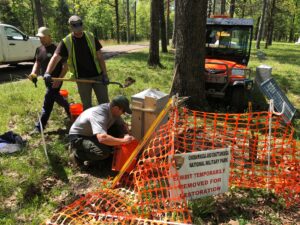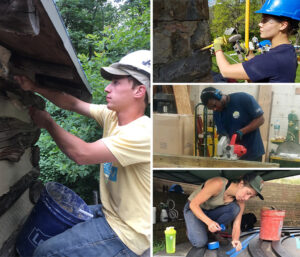Construction has a labor supply problem. This week, CNN Business published an article entitled America desperately needs 1 million more construction workers. The Campaign for Historic Trades, powered by Preservation Maryland, is a national effort to reshape the landscape of historic trades. The organization builds out training programs and creates hands-on opportunities for individuals looking to build careers.
Preservation cannot happen without skilled hands to perform the work
Demand outmatches the supply of trained tradespeople. To preserve our country’s irreplaceable history, it’s vital to dramatically increase pipelines into trades programs and ensure quality craftsmanship. The current system is complex and rife with access barriers for non-traditional demographics. Existing professionals lack national support networks and certification standards. The Campaign is working to resolve these issues with innovative partnerships and programming.
The 2008 economic crash decimated the industry. Between 2007 and 2009, nearly 2.5 million tradespeople voluntarily and involuntarily left the construction sector. It’s been a slow recovery as fewer young people enter the trades and the once-ubiquitous shop classes continue to shutter in high schools across the country. Pipelines into the trades are drying up and being removed systemically. The result: the demand for construction has outpaced the supply of workers. 
Additionally, these are dangerous jobs. In 2019, 5,333 Americans died while on the job; 20% of those were construction workers. Construction and maintenance account for 4/10 deadliest occupations. 2019 also recorded over 4 million lost time workplace injuries in construction and maintenance. These are just the recorded and traceable deaths and injuries. Construction workers risk their lives and well-being everyday on the worksite. 
Career and Technical Education (CTE) saw a slow decline throughout the 20th century. Starting in the 1980s, programs have closed across the country. Reasons for this vary. Three major factors are academic policy changes, difficultly finding qualified instructors, and the expense of maintaining and purchasing equipment. There is also a branding problem. Author and researcher Sir Ken Robinson argued that educational systems wrongly equate academic learning achievements with intelligence, and relegate students with lower grades to vocational programs. Robinson stated that “this academic/vocational caste system is one of the most corrosive problems in education.” This misperception negatively impacts tradespeople’s wages and reduces people’s desire to pursue trades careers. Technical vocations bring academic learning to real-world applications, such as a measuring, laying out and cutting timberframe joinery. It requires tactical skill, knowledge, and intelligent discretion.
The Campaign for Historic Trades is fighting for CTE and training. We’re developing paid pipelines into the trades, coupled with college curriculum. That way, apprentices can earn income while they earn a college degree. To professionalize these career paths, we’re partnering with trade organizations to set standards and support working tradespeople.
Government also has to play a role. Local, state, and federal agencies need to support CTE programs at all levels. Construction businesses are expensive to run and it is costly to train new workers. Because the work is dangerous and requires costly equipment, there is a profitability cliff for small and mid-sized businesses. This lack of mid-sized businesses results in more expensive work and/or unsafe work from unqualified people working “under the table.” Construction is not just another commodity. It’s essential infrastructure to the country. The recent disaster in Surfside, Florida, demonstrates both the importance of quality construction and maintenance. Improper construction and care is monetarily costly and potentially deadly. The country needs to decide to value construction labor and treat it as an important and essential profession.
- https://www.bls.gov/opub/mlr/2011/04/art4full.pdf
- https://www.bls.gov/spotlight/2014/housing/pdf/housing.pdf
- https://www.bls.gov/news.release/pdf/osh.pdf
- https://www.cnn.com/us/live-news/miami-florida-building-collapse-07-03-21/index.html
- https://www.cnn.com/2021/07/08/economy/construction-worker-shortage/index.html
- https://time.com/3849501/why-schools-need-to-bring-back-shop-class/
- https://www.latimes.com/archives/la-xpm-1986-06-12-ga-10532-story.html
- https://www.brookings.edu/research/what-we-know-about-career-and-technical-education-in-high-school/
